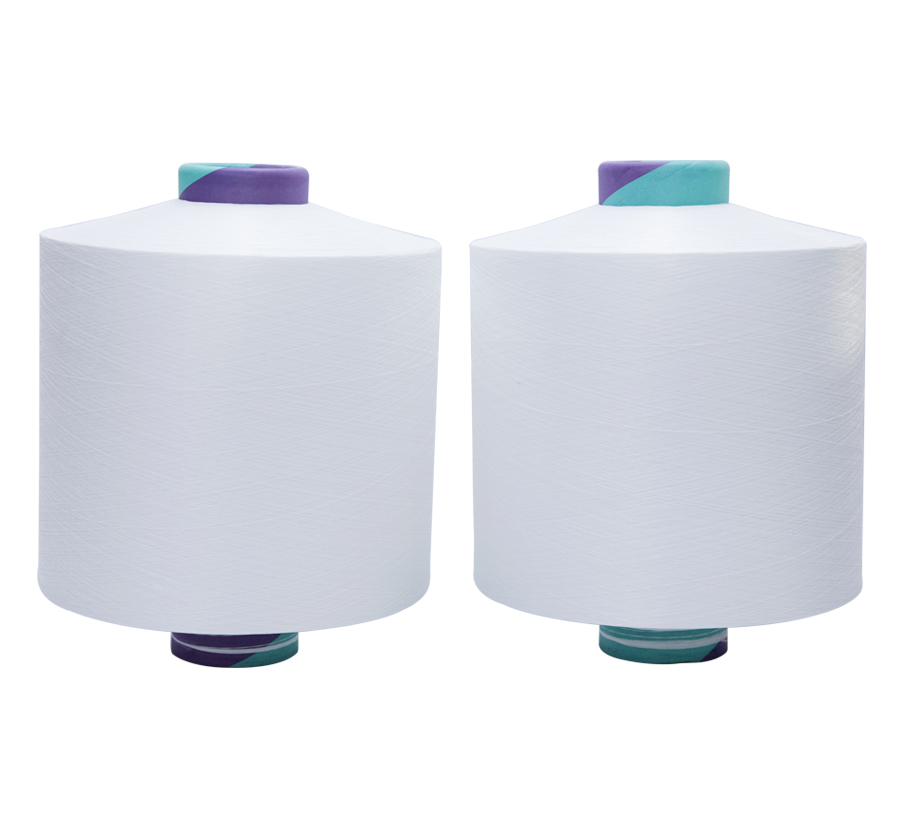Recycled 150D48F RW HIM Polyester Yarn Type: Polyester Yarn Pattern: Raw Technic...
See Details1. The characteristics of knitting engineering and its requirements for yarn thickness and detail
Knitted fabric is made by using knitting needles to turn each yarn into a loop, and then weaving the loops in tandem. The structure of knitted fabric is loose, and there are more gaps inside the yarn loop and between the yarn loop and the yarn loop. The unevenness of the original yarn and the large number of thick details will affect the stability of the thread during the knitting process, make the size and shape of the knitted loops different, and affect the clarity of the texture of the fabric, especially the details are fatal to the knitting engineering. When the details are 20% thinner than the original yarn, shadow details will appear on the knitted fabric surface; when the details are 35% thinner than the original yarn, obvious details will appear on the knitted fabric surface; when the details are smaller than the original yarn When the yarn is 70% thinner, the knitting fabric will show "one-size-fits-all" details. Moreover, the yarn has low strength in the details and is easy to break. The hook series structure of the knitted engineering yarn loop has the characteristic of dispersing. When the yarn has a broken point, the yarn loop that is hooked and covered with it will be Disintegration, forming a hole in the fabric, affecting the normal progress of the knitting project, affecting the efficiency of weaving, reducing the rate of product production, and reducing the service life of the cloth. Therefore, the knitting yarn has strict requirements for the thickness of the kilometer.
2. Analysis of test range of capacitive evenness tester and yarn defect tester
The capacitive evenness tester is an instrument used to detect yarn evenness and frequent yarn defects. It is mainly used to detect the coarse details and unevenness of short segments. The detected coarse details are shorter than the average fiber The length of the coarse details, when the length of the coarse details exceeds the average length of the fiber, will be treated as unevenness, and the number of coarse details will not be recorded. The principle of the evenness tester to detect frequent yarn defects is to allow the yarn to pass between the parallel plate capacitor plates at a certain speed according to the different dielectric coefficients of the yarn and the air, and to collect the electricity caused by the change in the quality of the yarn per unit length. The capacity change signal is converted into an electric signal, and compared with the change amplitude of the electric signal of the set grade, when the change amplitude of the electric signal caused by the yarn quality change reaches or exceeds the change amplitude of the electric signal of the set grade Value, that is, a defect of that grade is recorded,

Capacitive yarn defect meter is an instrument used to detect occasional yarn defects of yarn, mainly used to detect occasional coarse details with larger amplitude or longer length. The principle of detecting sporadic yarn defects by the yarn defect meter is that when the yarn defect on the yarn passes between the capacitive plates on the detection head, the detected yarn defect signal is converted into an electrical signal, and then converted into a digital signal, and sent to The microcomputer performs storage and calculation, and records the number of defects that exceed the set amplitude and length respectively.
By comparing and analyzing the detection characteristics of the evenness tester and the yarn defect tester, we can find that the conventional detection ranges of the two have a common blind zone: in terms of the yarn defect amplitude, the evenness tester can only reach the detection sensitivity for details- 30%, the detection sensitivity for thick knots can only reach +35%, the detection sensitivity of the yarn defect instrument for details can only reach -35%, and the detection sensitivity for thick knots can only reach +45%. Details within -30% of the original yarn and thick sections within 35% thicker than the original yarn cannot be detected, and the corresponding detection results cannot be provided; in terms of yarn defect length, the interval from the average fiber length to 8cm Neither the details nor the thick sections inside can be detected, and the corresponding test results cannot be provided. But for knitting yarn, when the fineness of detail is -20% thinner than the original yarn, shadow defects will appear on the cloth surface, and thick knots that are 35% thicker than the original yarn will also affect the cloth surface dryness. Obviously, only relying on the conventional evenness tester and yarn defect tester can not reflect the real effect of the fabric surface after the yarn is woven into the knitted fabric.